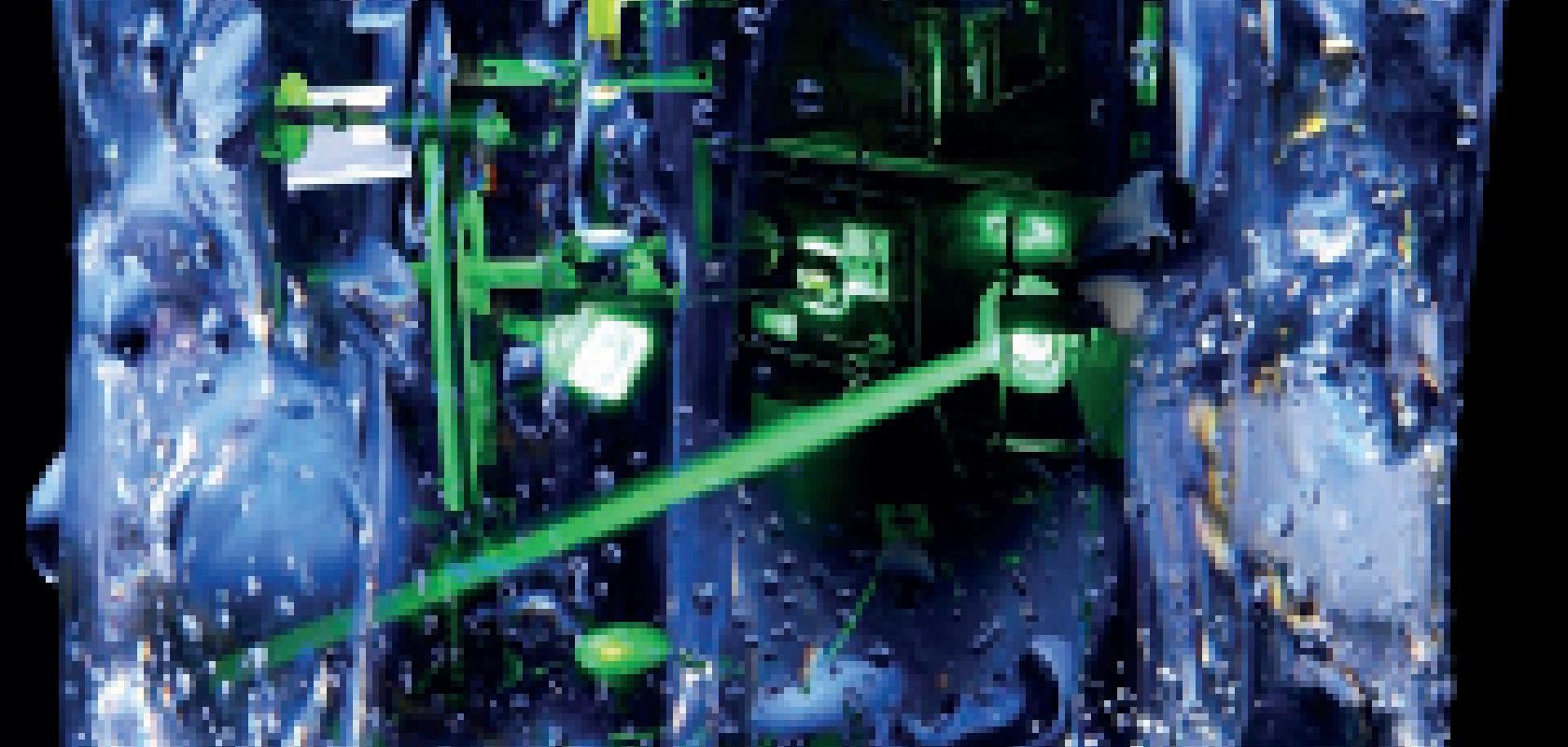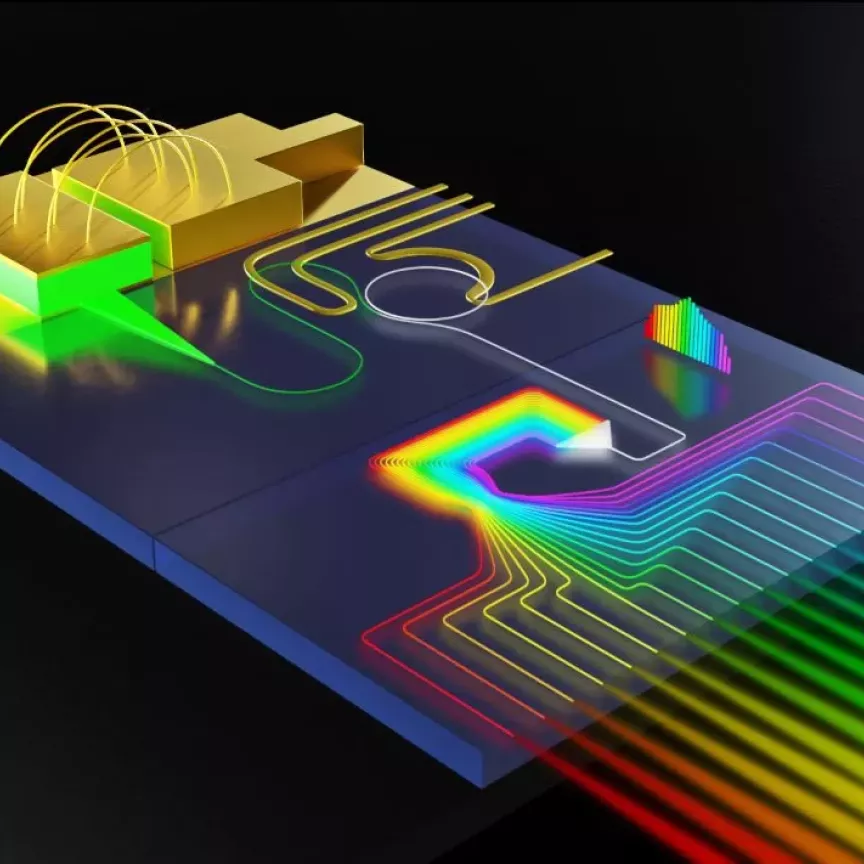There is no question that laser diodes are increasing in power every year. While this increase in power brings new applications and new markets, it also brings with it a big problem – waste heat.
The main challenge facing laser diode manufacturers today is not how to make more powerful lasers, but how to cool them so that they last long enough to be of use.
The lifetime of the package, which houses the laser diode bar and the cooling mechanism, is today the limiting factor in many laser diode applications. The most common method of removing large amounts of waste heat in laser diode arrays is through the use of copper-based microchannel coolers. These involve pumping a cooling liquid through the microchannels to remove the heat. In the majority of commercially-available coolers, the coolant is in electrical contact with the diode bars. This requires the use of deionised water, which places increased demands on the cooling system and also causes erosion and corrosion, and ultimately, failure of the microchannel coolers.
Michael Leers is head of the packaging group at Germany’s Fraunhofer Institute for Laser Technology. He says: ‘New cooling technologies are urgently needed, but so far no technology has replaced copper microchannel coolers. Companies seem to accept the fact that after 10,000 to 25,000 hours they will need to change their laser arrays despite the fact that it is usually the cooling technology and not the laser that needs replacing. Any technology aimed at replacing conventional cooling systems will have to demonstrate a lifetime of more than 20,000 hours and this is why we have not seen any new viable technology for several years.’
However, he believes there are several developments in the pipeline that show great promise. Companies around the world are working with new materials such as copper alloys or diamond, and new designs such as double-sided cooling and impingement coolers.
For example, Jenoptik Laser in Germany has succeeded in doing something that looks like a really simple idea, but in practice is extraordinarily difficult to implement – cooling both sides of the laser diode bar. Most laser diode cooling technologies cool the laser chip only from one side – the p-side – which is located directly above the microchannels. The n-side is usually left uncooled, with wire bonds or thin copper sheets used as n-contacts. ‘Water cooling both sides of the laser is usually only done for record attempts to determine the maximum optical output power of diode laser bars,’ says Leers. ‘These packages often only have a lifetime of a few hours, because the laser cannot endure the resultant mechanical and thermal stresses. Conductive cooling both sides of a laser diode bar can significantly improve the cooling performance but there are considerable challenges to overcome.’
Jenoptik’s Ekkehard Werner and Petra Hennig believe they have found the solution. ‘Our CN package cools the laser from both sides, passively, without the need for microchannels and their associated problems,’ says Hennig. ‘This may seem like a simple idea, but the mechanical stresses experienced by the laser on each side are not equal. We had to find the right solder, the right pressure, adjust the geometry of the structure and change the surface quality of the heatsink. It has taken several years of tweaking, but we are now ready to go to market.’
Jenoptik claims that the performance of its two-sided passive technology is comparable with actively-cooled microchannel technology. Its thermal resistance has been reduced from 0.6K/W to 0.3K/W and this has enabled a laser optical efficiency increase of more than five per cent when compared with standard passively cooled heat sinks.
Jenoptik has patented this approach, so other companies have had to come up with other solutions to the problem.
This can lead to some innovative thinking. For example, UK company Versarien is commercialising a technology developed at the University of Liverpool – copper foam. Copper foam can be manufactured using the lost carbonate sintering (LCS) technology developed by Professor Yuyuan Zhao at the University of Liverpool. In this process, copper powder and carbonate powder are mixed together, compacted and sintered. As the carbonate powder starts to decompose is it removed and leaves behind an open cell network of holes. The size of the holes and the porosity of the foam can be controlled by using the right particle size of carbonate powder. ‘Forcing a liquid coolant through the porous copper can take away a large amount of heat,’ says Zhao. ‘We have shown that LCS copper has a superior performance in this respect to many current products.’
A foam structure will inherently have a greater surface area than a conventional microchannel cooler and so has the potential to extract more heat. But turning this idea into a commercial product is, as always, not easy.
But Will Battrick, technical director of Versarien, is optimistic. ‘We hope to have product on the market by the end of the year,’ he says. ‘We are developing copper-tungsten alloy foams with coefficients of thermal expansion (CTE) that are matched to semiconductors, such as GaAs used in laser diodes. While this alloy does not have the same thermal conductivity as pure copper, we believe the resultant reliability and CTE matching will more than make up for this. The cost of manufacturing is also an order of magnitude lower than conventional microchannel coolers, as ours is not a subtractive process.’
Porous copper, however, will have the same corrosion issues as copper microchannel coolers. One way of mitigating corrosion is by coating the copper with a protective layer, which would be feasible due to the foam’s open cell structure.
US company Advanced Cooling Technologies (ACT) is hoping that coating conventional microchannel coolers could help alleviate some of the problems. It is developing a passivation process that will result in a pin-hole free protective coating for nickel-gold (Ni/Au) plated copper micro-channel coolers. This proposed approach will use atomic layer deposition (ALD) to deposit highly uniform ceramic thin films on commercially available coolers. The ALD coating will provide corrosion resistance and erosion protection for the micro-channel, thereby increasing reliability. To increase the strain tolerance of the ceramic coating and eliminate any pinholes in the coating, the micro-channel surface will be pretreated with an organic self-assembled monolayer. This layer will provide an ideal surface for ALD bonding, improve uniformity by masking surface defects in the metal, and provide compliance for any mismatch in the thermal expansion coefficient. Peter Ritt, vice president of technical services at ACT, says: ‘In my discussions with laser manufacturers, corrosion of microchannel coolers is the Number 1 life issue. Our programme is on-going, but we hope to have some results we can share next year. We hope this innovative metal-organic-ceramic combination will allow Ni/Au-plated copper microchannel coolers to transition from primarily laboratory use to an economical means of cooling commercial and military high power laser diode systems.’
Ceramic materials also feature in some other emerging products in this field. For example, German company Curamik Electronics is using an aluminium nitride (AlN) layer in its ILasCo microchannel cooler to isolate the electrical circuit from the cooling circuit. While this gives a lower cooling performance, it gives a better CTE match to GaAs laser diodes, and means the microcoolers can be used with standard filtered water, rather than deionised water. ‘Our microchannels are still made in copper, but because the copper is now electronically isolated, there is no electrical corrosion,’ explains product manager Manfred Goetz. ‘We are targeting lifetimes of around 50,000hrs and are currently waiting for feedback from a couple of customers before we officially release the product onto the market.’
Because of the electrical isolation, stacking the laser diode bars can be a challenge. Curamik has had to increase the width of the package to up to 20mm in order to fit in vias that are capable of feeding 100A through the stack. ‘We know that customers want a direct replacement for conventional copper microchannel coolers, but our solution will require our customers to think a little bigger,’ says Goetz. ‘We realise we will have to work hard to persuade some companies that changing the form factor is worthwhile, but we believe the change is necessary in order to achieve the increased performance.’
While Curamik’s approach is a hybrid copper/ceramic technology, US company Cutting Edge Optronics (CEO) is going one step further and has decided to move away from copper completely and use an entirely ceramic material instead. ‘We have developed a ceramic microchannel cooler that provides excellent thermal performance and does not require the use of deionised water,’ says Ryan Feeler, sales manager at CEO.
The company’s ceramic microchannel coolers are produced using high-temperature co-fired ceramic (HTCC) technology, which is well-known in the microelectronics industry, but has so far not seen common use in the laser diode industry. HTCC has also been widely used in microfluidic applications, including many applications where harsh chemicals flow through the device. CEO has leveraged the conventional thick film processing and bonding techniques of the HTCC industry to create multi-layer devices with water channels similar in nature to copper microchannel coolers.
One big difference between ceramic and copper versions is that the ceramic design uses an electrically-isolating, thermally conductive heat sink in the thermal path between the bar and the cooling water. This heat sink is called a thermal window and is typically made of aluminium nitride, beryllium oxide, or diamond. The thermal window is attached to the cooler during the manufacturing process and causes the diode bar to be electrically isolated from the coolant path. This eliminates the need for deionised coolants and enables the use of standard filtered water, along with a number of other exotic coolants.
‘While the HTCC process is an established manufacturing technique, making a product that was suitable for high-volume manufacture and that meets the requirements of the laser industry was very challenging,’ says Feeler. ‘We started development in 2006, hoping it was a two-year process, but we are only now ready to go to market. Our aim is to steer all our customers towards using ceramic coolers and eventually replace copper coolers completely.’
Other companies are not ready to give up on copper and are looking at new designs of microchannels in order to improve the cooling efficiency and hence the lifetime and power of the laser diode bar. US company Sommerville Laser Technology (SLT) has developed what it calls the enhanced performance impingement cooler (EPIC). In conventional coolers, the cooling channels run parallel to the die-attach surface. This presents two problems: the pressure required to force water through the channels can be large; and water immediately adjacent to the microchannel wall has zero flow velocity, creating a boundary layer that impedes the removal of heat.
SLT’s solution is to turn the channels 90° and make them perpendicular to the die attach surface. ‘The effect is essentially an array of fire hoses spraying water on the hot surface,’ says Aland Chin, CEO of SLT. ‘The large number of nozzles allows greater removal of heat compared to standard microchannel coolers.’
Using an EPIC heat sink, researchers from SLT and Science Research Laboratory were able to achieve record 250W continuous-wave output power from a single, 20 per cent fill-factor, 1cm diode bar at 20°C. ‘This record brightness was made possible, because the EPIC heatsink has a heat removal capacity exceeding 3kW/cm2,’ says Chin. ‘This paradigm shift in internal architecture provides high coolant contact area with low pressure loss.’
As with all the above technologies, SLT’s EPIC heat sink is just emerging onto the market and the company is in the process of determining the lifetime of its product.
If EPIC and all the other technologies mentioned above are able to exceed the 20,000hrs of operation that are required for industrial applications the future looks even brighter for laser diode applications.


